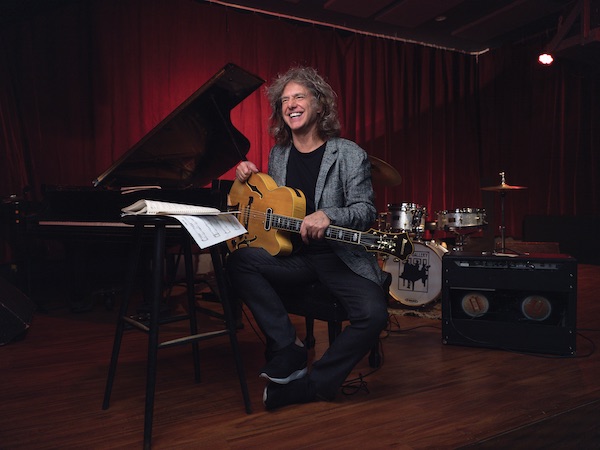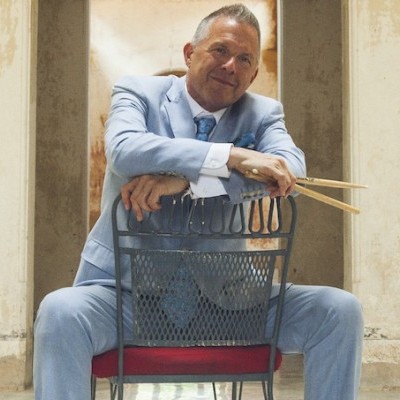Oct 28, 2025 10:47 AM
In Memoriam: Jack DeJohnette, 1942–2025
Jack DeJohnette, a bold and resourceful drummer and NEA Jazz Master who forged a unique vocabulary on the kit over his…

Over the course of his career, Pat Metheny has edged closer to the orchestral vision reflected on his latest release, From This Place.
(Photo: Jimmy & Dena Katz)Like them, Broadbent is prolific, having created the orchestral settings for dozens of successful albums featuring celebrity pop and jazz singers, including Barbra Streisand, Linda Ronstadt, Natalie Cole, Michael Bublé, Michael Feinstein, Shirley Horn, Sheila Jordan and Diana Krall. But Broadbent also excels at the small group format: For decades he arranged for and played in Haden’s celebrated Quartet West.
Broadbent borrows from both of these environments for Metheny’s album. On “From This Place,” for instance, his shimmering symphonic passages augment Meshell Ndegeocello’s pure vocals without subverting the song’s message. Given the weightiness of the lyrics—references to injustice, resistance, despair, hope—anything heavier than the most respectful touch would be too much. But Metheny’s solo on the tune—an isolated, lamenting line—is all the more heartbreaking against the color of the orchestra’s swelling harmonies. In this case, Broadbent’s hand masterfully moves the drama of the piece forward.
“Alan and Gil are heroes for me. What they both brought to this, I can’t even say,” Metheny said. “When I got the first demo charts back, I practically started crying. They were just so advanced and so awesome.”
Metheny knew that the charts, based on the live feel of his quartet, needed a particular sound from the orchestra, one that supported the emotional heft of the material. He received some bids from European orchestras; by reputation, European orchestral players, with their exacting approach to a score, are some of the best in the world. But again, Metheny was hearing something different.
“There is willfully a kind of Hollywood component to this album,” he observed. “I have never resisted what I love, and I love that very American film score sound.”
To achieve that sound, Metheny hired the Hollywood Studio Symphony, conducted by Joel McNeely. Recorded on the same Los Angeles sound stage as the music to the 1939 film The Wizard of Oz, the album’s final tracks thrilled Metheny. “The orchestral days out [in L.A.] were just pure joy,” he said. “It was one of the best experiences I’ve ever had as a musician.”
For Metheny, what distinguished the L.A. orchestra from others was not just the players’ technical expertise and their familiarity with American grooves, but also their understanding of the emotional nature of his compositions. “This music is hard, and I really demand an emotional connection [to it] from everyone, including the orchestra,” he said. “The first thing I did at the session was get up and talk to them about what this is.”
Even as bassist Oh admires Metheny’s attention to the tiniest details in his music (and seeks to emulate it), she commends the emotive impact of his large-scale vision. “Pat has always been known for writing very cinematic pieces,” she said. “His music is always about drama, full of emotion. I think people need that right now, to be honest. He is such an incredible force of nature.”
The album’s cover art depicts a dark tornado swirling ominously close to the viewer, an apt symbol for Metheny’s take on the current social climate. He wrote the music for the title tune—the seed thought for the album—the day after the 2016 presidential election, in the early morning hours. The song’s lyrics (written by Alison Riley) convey that the future is uncertain; despite this, the protagonist affirms love and freedom as resolute guiding principles. In the relentlessly beautiful sonority that Metheny champions throughout the album, this is the idea that predominates.
“I’ve always been tuned into the forces that form our culture, and those forces absolutely make the new album what it is,” he said. “But years from now, these forces will be incidental to what the record is. I’ve been using this analogy: The diamonds that exist in the world were formed by dirt and all kinds of funk, right? But we don’t remember the dirt and the funk—we only remember the diamond. And in this case, ‘dirt’ is the operative word. There’s a lot of dirt [in the culture] right now ... but one of the great things about being a musician is that we’re trading in a currency that’s actually true.”
As an improvisatory musician, he went on, “you must be in the time you’re in. Otherwise [the music] doesn’t have the authenticity, truth and power that fuels what it sounds like. When I think about my favorite musicians, each one of them has been really of the time that they’re in, creating something that goes way beyond that.”
He cited Hancock as an example: “If you just say ‘Herbie,’ in that name you get a whole sonic world that includes everything about who he is. There’s a sound component to it, but how it relates to the larger culture is also interesting.”
Even as he parses the cultural climate of today, Metheny prefers to focus on the evergreen nature of music, on that which defies time and place. No amount of technical knowledge about harmonic substitutions, rhythmic displacement and metric modulation will lead to transcendence on the bandstand, he explained. Instead, he acknowledged the importance of an elusive factor: “It’s the merging of consciousness on this side and the soul on that side. It’s really unknowable. But there’s a poetry in that, [and it] informs every aspect of our humanity.”
Shortly after the album’s Feb. 21 release, Metheny’s quartet will embark upon a three-continent tour. They’ll hit some shores they haven’t yet visited as a band—Cuba and Oh’s native Australia. If they play material from the new album, it will be without strings: It’s too expensive to jet an orchestra around the world, and the music is too complex for a regional orchestra to pick up quickly. Metheny expressed doubt that he would ever be able to mount an orchestral tour for From This Place.
Metheny will travel abroad for a large part of 2020 with his various ensembles, each with its own ethos. In the spring, he’ll tour Europe with his Side-Eye trio, a showcase for young talents, this edition of the band featuring pianist/keyboardist James Francies and drummer Marcus Gilmore.
He’s looking forward to the continuation of another project, too. “[Ron Carter and I] are still going to do more gigs. It’s great playing with Ron,” he said. “If I had to pick 20 all-time favorite records, he’s on 12 or 13 of them—and not just the Miles stuff. We get to hang out a lot when we’re traveling, and he’s very happy to talk about his memories of things.”
And for Metheny, those memories stand out as diamonds in the funk. DB

Jack DeJohnette boasted a musical resume that was as long as it was fearsome.
Oct 28, 2025 10:47 AM
Jack DeJohnette, a bold and resourceful drummer and NEA Jazz Master who forged a unique vocabulary on the kit over his…

Always a sharp dresser, Farnsworth wears a pocket square given to him by trumpeter Art Farmer. “You need to look good if you want to hang around me,” Farmer told him.
Sep 23, 2025 11:12 AM
When he was 12 years old, the hard-swinging veteran drummer Joe Farnsworth had a fateful encounter with his idol Max…

D’Angelo achieved commercial and critical success experimenting with a fusion of jazz, funk, soul, R&B and hip-hop.
Oct 14, 2025 1:47 PM
D’Angelo, a Grammy-winning R&B and neo-soul singer, guitarist and pianist who exerted a profound influence on 21st…

Kandace Springs channeled Shirley Horn’s deliberate phrasing and sublime self-accompaniment during her set at this year’s Pittsburgh International Jazz Festival.
Sep 30, 2025 12:28 PM
Janis Burley, the Pittsburgh International Jazz Festival’s founder and artistic director, did not, as might be…

Jim McNeely’s singular body of work had a profound and lasting influence on many of today’s top jazz composers in the U.S. and in Europe.
Oct 7, 2025 3:40 PM
Pianist Jim McNeely, one of the most distinguished large ensemble jazz composers of his generation, died Sept. 26 at…